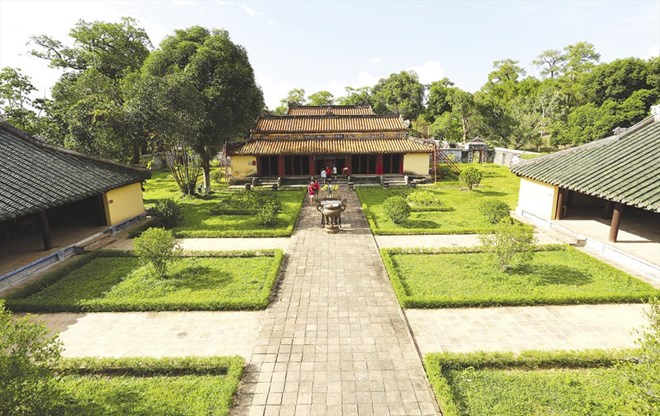
King Gia Long's tomb is located at the upper reaches of the Perfume River - one of four mausoleum clusters with beautiful landscapes. Photo: NDT
In East Asia, such well-preserved areas are rare.
At the International Workshop on sustainable management and use of cultural landscapes, historical-ecological systems at the Nguyen Dynasty Royal Tombs and the upper Huong River basin; Research cooperation program between the Hue Monuments Conservation Center (HMCC) in collaboration with the Institute for Urban and Regional Studies, Waseda University, Japan (WIURS) held in Hue city, Dr. Phan Thanh Hai - Director of the HCMCC informed that the purpose of the workshop is to share research of both sides on the values, characteristics and potential of cultural landscapes and historical-ecological environment at the Nguyen Dynasty Royal Tombs area associated with the upper Huong River basin.
“The preservation of the Nguyen Dynasty relic system is sustainable only when the natural landscape and environment are managed, exploited reasonably and protected thoroughly based on Vietnamese law and World Heritage Conventions. Natural landscape is always considered an important element in the structure of architectural space in general and the space of a heritage (object) in particular. For the Hue Monuments Complex - the first World Cultural Heritage site of Vietnam, the natural landscape factor is even more important,” Mr. Hai shared.
Mountains and rivers have created the terrain of the Perfume River basin and there are cities, towns, villages, settlements and sacred spaces such as royal tombs and ancient temples, hidden in military relics scattered in the Perfume River area.
“Characteristics and potential of the cultural landscape and historical ecological system designed in the periphery of the Nguyen Dynasty royal tombs - Principles of composition and techniques of “Historical-Ecological Museum Area” in the Perfume River area. It is rare to have such well-preserved areas in East Asia. Hue, an ancient city formed according to the Chinese Feng Shui theory, has introduced a series of environmental techniques, reviving the waterway system and being friendly to all climates” - said Prof. Dr. Satoh Shigeru from the Institute of Urban and Regional Studies, Tokyo Metropolitan University, Japan.
Deserving of world heritage recognition
According to the ancients, the geographical location of Hue is not only important in terms of transportation and defense but also has special significance in terms of feng shui. The important architectural clusters of Hue planned under the Nguyen Dynasty were all designed in association with feng shui landscape elements, especially lakes (or rivers, streams, etc.), An Mountain, Chau Mountain, etc. The famous images and landmarks of Hue that have entered poetry, music and painting are also feng shui elements of Hue royal architecture such as Huong River, Ngu Binh Mountain, Hen Islet, Da Vien Islet, etc. Feng shui elements such as hills, mountains, rivers, lakes, etc., the waterway system of each mausoleum area is like a connection of these feng shui elements, creating a cultural landscape and ecosystem typical of the Nguyen Dynasty royal mausoleum area and the mausoleum relics associated with the upper Huong River area.
This is a place that preserves rich material and spiritual cultural values, including: agricultural products, spiritual world (concepts of life, religion and beliefs), irrigation, water management system and historical, cultural and traditional elements (community activities, festivals...) are all integrated into the cultural landscape of the Perfume River basin. The waterway system and historical ecological environment are designed and arranged in the upper Perfume River basin, with particularly important functions, currently managed and maintained by the local government and people.
Mr. Phan Thanh Hai said that the Nguyen Dynasty royal tomb complex associated with the upstream area of the Perfume River is an area of great value in many aspects, worthy of being recognized as a World Heritage Site because of its diverse elements that are comprehensively integrated and gathered around the natural ecosystem along the Perfume River from Hue Citadel to the royal tombs and the system of residential villages.
“The results of this workshop will be considered for inclusion in the re-nomination dossier for the Hue Monuments Complex with the new criteria of World Cultural Landscape Heritage. This is a step forward to more comprehensively protect the values of Hue cultural heritage. This is also an effort of the Center in particular and Thua Thien - Hue province in general in building a re-nomination dossier to once again honor the Hue Monuments Complex as a World Cultural Landscape Heritage according to the recommendations of UNESCO and the Ministry of Culture, Sports and Tourism in recent years,” said Mr. Hai.
Mr. Furukara Naoaki - Assistant Professor, Lecturer of Tokyo Metropolitan University said that the heritage in the Perfume River basin where the four tombs of the first king are located is designed in an area surrounded by green hills and mountains, each tomb has a nearby waterway system (lake, river); the tombs and neighboring villages have created a unique cultural landscape and ecosystem. The studies will clarify the characteristics of the cultural landscape and will have necessary conservation methods of these heritages.
Source: https://laodong.vn/lao-dong-doi-song/thuong-nguon-song-huong-noi-yen-nghi-cua-hoang-gia-trieu-nguyen-599602.ldo


![[Photo] Prime Minister Pham Minh Chinh attends the groundbreaking ceremony of two key projects in Hai Phong city](https://vphoto.vietnam.vn/thumb/1200x675/vietnam/resource/IMAGE/2025/9/27/6adba56d5d94403093a074ac6496ec9d)


































































































Comment (0)